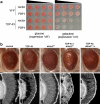Model organisms reveal insight into human neurodegenerative disease: ataxin-2 intermediate-length polyglutamine expansions are a risk factor for ALS
- PMID: 21660502
- PMCID: PMC3207127
- DOI: 10.1007/s12031-011-9548-9
Model organisms reveal insight into human neurodegenerative disease: ataxin-2 intermediate-length polyglutamine expansions are a risk factor for ALS
Abstract
Model organisms include yeast Saccromyces cerevisae and fly Drosophila melanogaster. These systems have powerful genetic approaches, as well as highly conserved pathways, both for normal function and disease. Here, we review and highlight how we applied these systems to provide mechanistic insight into the toxicity of TDP-43. TDP-43 accumulates in pathological aggregates in ALS and about half of FTD. Yeast and fly studies revealed an interaction with the counterparts of human Ataxin-2, a gene whose polyglutamine repeat expansion is associated with spinocerebellar ataxia type 2. This finding raised the hypothesis that repeat expansions in ataxin-2 may associate with diseases characterized by TDP-43 pathology such as ALS. DNA analysis of patients revealed that intermediate-length polyglutamine expansions in ataxin-2 are a risk factor for ALS, such that repeat lengths are greater than normal, but lower than that associated with spinocerebellar ataxia type 2 (SCA2), and are more frequent in ALS patients than in matched controls. Moreover, repeat expansions associated with ALS are interrupted CAA-CAG sequences as opposed to the pure CAG repeat expansions typically associated with SCA2. These studies provide an example of how model systems, when extended to human cells and human patient tissue, can reveal new mechanistic insight into disease.
Figures



References
-
- Brand AH, Perrimon N. Targeted gene expression as a means of altering cell fates and generating dominant phenotypes. Development. 1993;118:401–415. - PubMed
Publication types
MeSH terms
Substances
Grants and funding
LinkOut - more resources
Full Text Sources
Medical
Molecular Biology Databases
Research Materials
Miscellaneous

